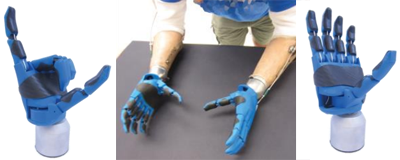|
|
Prosthetic Hands |


|
|
Over 10,000 major amputations of the upper extremities occur every year in America. However, while technology has improved drastically, very few advances in prosthetic devices have been adopted by the amputee community in the last century. During their everyday lives, most patients still choose hooks or other simple mechanisms as terminal devices for functionality, switching to a less functional, more cosmetic terminal device for social activities. We would like to address this dichotomy by working towards the development of a hand prosthesis that is both multi-functional and realistic. Size and weight constraints as well as limitations inherent with both myoelectric and body-powered methods of control and actuation limit the number of degrees of actuation that can reasonably be incorporated into a prosthesis. The strategy we have taken with hand design fits well with this problem: careful choice of compliance, smart design of joint coupling, and an emphasis on durability. Using our experience in underactuated robotic hands, we have developed multiple prosthetic hand prototypes that function through EMG signals and body powered methods.
Sample Publication:
Joseph T. Belter, Michael T. Leddy, Kevin D. Gemmell, and Aaron M. Dollar
Comparative Clinical Evaluation of the Yale Multigrasp Hand, proceedings of the 6th Annual IEEE RAS/EMBS International Conference on Biomedical Robotics and Biomechatronics (BioRob), 2016.
Prosthetics
2016
All Prosthetics Publications >>
|